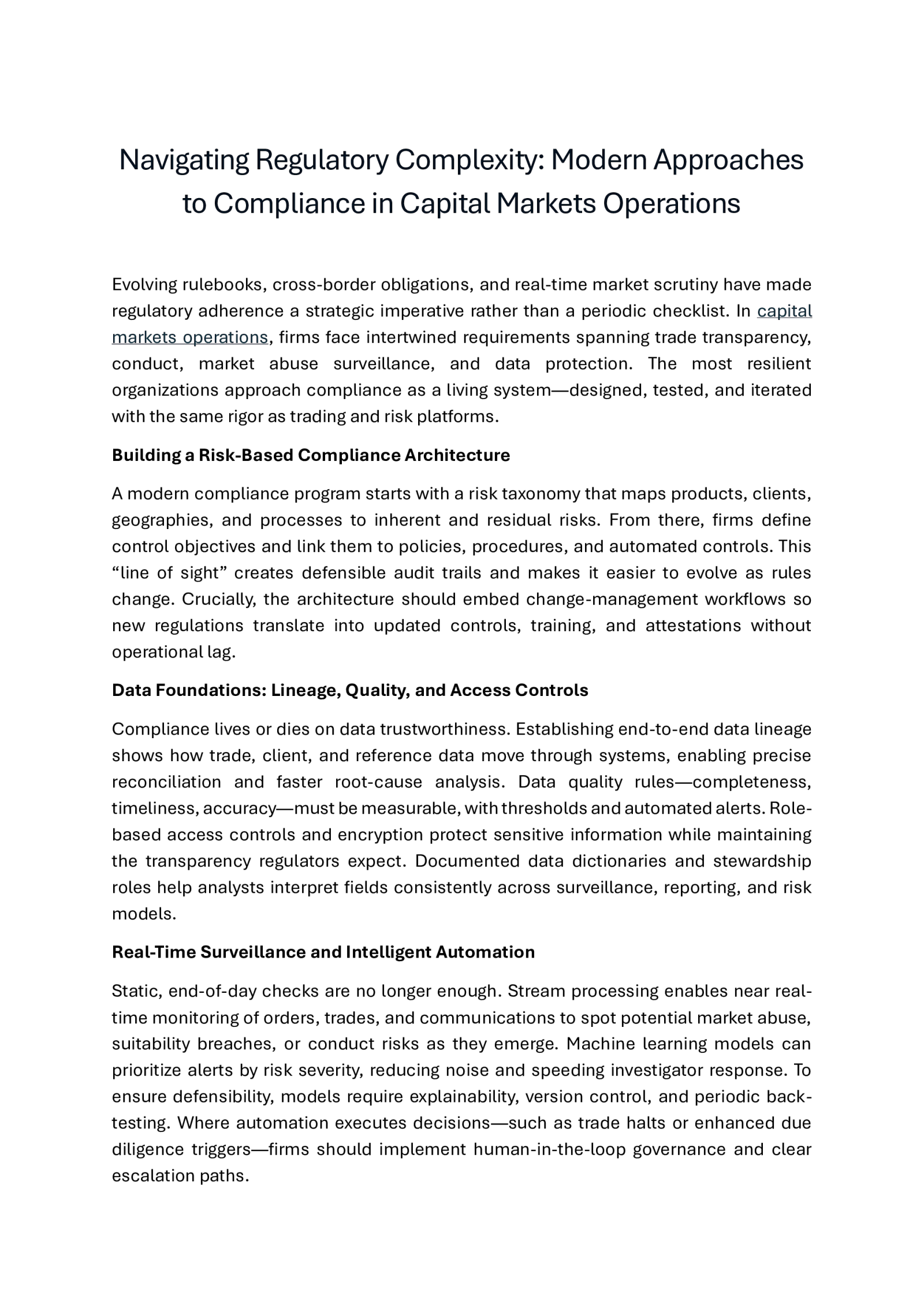A presentation at Capital Market Consulting & Advisory | Investment Management Services | Capital Market BPO | WNS in in New York, NY, USA by Keith Egbert

Navigating Regulatory Complexity: Modern Approaches to Compliance in Capital Markets Operations Evolving rulebooks, cross-border obligations, and real-time market scrutiny have made regulatory adherence a strategic imperative rather than a periodic checklist. In capital markets operations, firms face intertwined requirements spanning trade transparency, conduct, market abuse surveillance, and data protection. The most resilient organizations approach compliance as a living system—designed, tested, and iterated with the same rigor as trading and risk platforms. Building a Risk-Based Compliance Architecture A modern compliance program starts with a risk taxonomy that maps products, clients, geographies, and processes to inherent and residual risks. From there, firms define control objectives and link them to policies, procedures, and automated controls. This “line of sight” creates defensible audit trails and makes it easier to evolve as rules change. Crucially, the architecture should embed change-management workflows so new regulations translate into updated controls, training, and attestations without operational lag. Data Foundations: Lineage, Quality, and Access Controls Compliance lives or dies on data trustworthiness. Establishing end-to-end data lineage shows how trade, client, and reference data move through systems, enabling precise reconciliation and faster root-cause analysis. Data quality rules—completeness, timeliness, accuracy—must be measurable, with thresholds and automated alerts. Rolebased access controls and encryption protect sensitive information while maintaining the transparency regulators expect. Documented data dictionaries and stewardship roles help analysts interpret fields consistently across surveillance, reporting, and risk models. Real-Time Surveillance and Intelligent Automation Static, end-of-day checks are no longer enough. Stream processing enables near realtime monitoring of orders, trades, and communications to spot potential market abuse, suitability breaches, or conduct risks as they emerge. Machine learning models can prioritize alerts by risk severity, reducing noise and speeding investigator response. To ensure defensibility, models require explainability, version control, and periodic backtesting. Where automation executes decisions—such as trade halts or enhanced due diligence triggers—firms should implement human-in-the-loop governance and clear escalation paths.
Regulatory Reporting That Scales with Change Reporting obligations vary by venue, asset class, and jurisdiction. A modular reporting layer decoupled from core systems helps teams adapt quickly when schemas or fields change. Reference data hubs and golden sources reduce mismatches, while validation libraries catch format and logic errors before submission. Comprehensive runbooks, replay capability, and immutable logs enable swift remediation and transparent engagement with supervisors during inquiries. Cross-Border Compliance and Operating Model Design Global institutions benefit from a federated compliance model. Central teams set standards, methodologies, and tooling; regional teams tailor controls to local rules and market practices. Shared utilities—client onboarding, KYC refresh, and screening— deliver consistency and economies of scale, while local oversight preserves regulatory nuance. Clear RACI matrices, standardized metrics, and frequent tabletop exercises align stakeholders across the three lines of defense. People, Culture, and Continuous Assurance Technology cannot replace a strong compliance culture. Targeted training based on role and risk exposure improves judgment at the front line. Quality assurance and internal audit provide independent challenge, validating that controls work as designed. Key risk indicators—alert aging, model drift, data-quality breach frequency—offer early warning signals. Regular post-mortems turn incidents into playbook updates, closing feedback loops. Measuring Outcomes and Proving Effectiveness Regulators increasingly ask not just “Do you have controls?” but “Do they work?” Firms should track effectiveness metrics such as false-positive reduction in surveillance, timeliness of regulatory submissions, and remediation cycle time. Demonstrable improvement over time, backed by documentation and evidence, builds credibility with supervisors and stakeholders alike. The Way Forward Compliance excellence is a systems problem: data you can trust, controls you can explain, automation you can govern, and people who understand the “why.” Organizations that invest in these pillars transform compliance from a cost center into an engine of operational resilience and market confidence.
Unlock growth with WNS’ expert capital markets consulting and investment management solutions to improve efficiency, compliance, and financial outcomes.